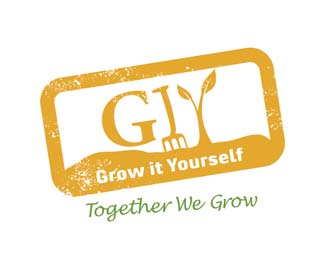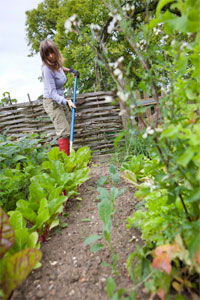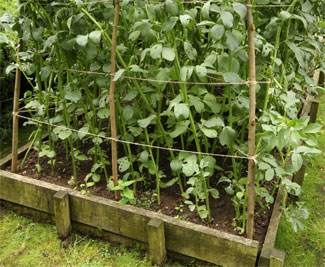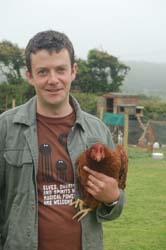Grow it Yourself - June
 Did a lot of transplanting this weekend, which is always a fun activity for a GIYer. There’s nothing like the satisfaction of planting seedlings – bare beds transformed in an instant with neat rows of little plants.
Did a lot of transplanting this weekend, which is always a fun activity for a GIYer. There’s nothing like the satisfaction of planting seedlings – bare beds transformed in an instant with neat rows of little plants.
There are always a few days of fretting after transplanting however – will cold nights set the plants back? Will slugs or rabbits try and munch on them?
Seed sowing is a relatively exact science – if you sow a seed at the right temperature and at the right depth, and you keep the potting compost moist, then it will generally germinate rather reliably.
 In addition, up to the point that they are transplanted, the seedlings have luxuriated in the 5-star comfort of my potting shed. They have been nurtured, spoiled, cossetted. I’ve carefully watered them each day, switched on heat underneath them at night and covered them with fleece.
In addition, up to the point that they are transplanted, the seedlings have luxuriated in the 5-star comfort of my potting shed. They have been nurtured, spoiled, cossetted. I’ve carefully watered them each day, switched on heat underneath them at night and covered them with fleece.
The potting shed is a controlled environment – there is no weather in there – no rain or wind. Nor are there any pests to trouble them – leather jackets, slugs, snails, birds or rabbits.
Planting a seedling out in the soil therefore is a watershed moment. It is the moment it leaves a very controlled environment in favour of something far more uncontrolled, unpredictable and messy. And like a parent sending a child off to school for the first time, you just have to have faith and let it go in to the mad, bad world!!
 Things to do this Month
Things to do this Month
To-Do
Watering and weeding duties step up a notch – the tunnel/greenhouse in particular will require a good deal of water from now on. Watch the weather and water outside as required. Continue to earth-up potato plants to prevent the spuds becoming green. Mulch and water tomato plants and continue to remove side shoots that appear in the leaf axils. Stake everything that grows tall – raspberries, peas, beans, tomatoes etc. Net soft fruit against birds – it’s worth the effort.
Sow
Sow courgettes, pumpkins, summer and winter squash, fennel, chicory.
Succession sow: beans (French and Runner), kale, pea, spinach, spinach beet, summer broccoli, carrot, swede, leek, lettuce, Brussels sprouts, beetroot, chicory, endive, turnip, kohlrabi, fennel.
Plant out: leeks, Brussels Sprouts, cabbage, autumn cauliflower, calabrese, sprouting broccoli, celery, celeriac, cucumbers, pumpkin, marrows, runner beans, aubergine.
Harvest
We are now really starting to see some payback from our GIYing - the first broad beans and peas as well as new potatoes, new carrots, soft fruit like gooseberries, cherries and strawberries. Herbs are in full flow. Also harvest kohlrabi, cabbage, cauliflower (month end), spinach, spring onion, shallots, salad leaves, elderflower, rhubarb, salad leaves, onions, carrots, beetroot, garlic, sea-kale.
Recipe of the Month – Broad Beans with Bacon
June is broad bean month – I love opening up the pods and seeing the little beans nestling in the comfy white fleece inside. The little green gems love to be paired with bacon. This recipe serves 4-6.
Ingredients:
• 30g butter
• 4 slices unsmoked bacon
• 1 medium onion, finely chopped
• 500g broad beans, shelled
• 125ml stock
Melt the butter in a pan. Add the bacon and onion and fry until the onion is soft but not coloured. Stir in the beans. Add the stock and bring to the boil. Cover and cook over a moderate heat for 6-8 minutes until the beans are soft but not mushy. If there is too much liquid in the pan at the end, boil briskly for 1-2 minutes to evaporate it. Serve immediately – this will make a lovely side dish or served by itself with some crusty or toasted bread.
Tip of the Month – Comfrey “tea”
Comfrey is a perennial herb that you can grow to harvest the leaves for an excellent liquid organic fertilizer. It has been found to contain as many nutrients as commercial tomato feeds. Harvest comfrey leaves and shove them in a bucket with a lid. Weigh the leaves down with a brick or something else heavy. Drill a hole in the base of the bucket and place a container underneath. As the leaves rot down a black liquid will start to drip down from the bucket in to the container. This is your comfrey feed. Dilute one part comfrey liquid to 15 parts water.
------------------------------------
We are trying to get 100,000 people to take a pledge to grow something they can eat – take the GIY pledge at www.facebook.com/giyireland.
 Michael Kelly is a freelance journalist, author and founder of GIY Ireland.
Michael Kelly is a freelance journalist, author and founder of GIY Ireland.
GIY is a registered charity that inspires people to grow their own and gives them the skills they need to do so successfully. There are 80 GIY groups around Ireland and 6,000 GIYers involved.
For more tips, information and support visit www.giyireland.com.
© GIY Ireland 2011 – all rights reserved.





There are currently no comments
Leave a comment
Not a member? Register for your free membership now!
Or leave a comment by logging in with: